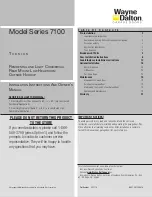
28
ENGLISH
8.2. LEVEL II - ADJUSTABLE FUNCTIONS
Important:
Level II is active only if the CODIS is used permanently
(function 7 of Level III activated). The CODIS programming unit
has one adjusting level.
Six parameters can be set. They are displayed on the right-
hand side of the CODIS front panel, with the relevant LEDs:
RESET
LED 6 o
RESET
: repeat initialisation process
(see paragraph 4.1).
LED 5 o
OPENING SPEED
: adjust to 30
÷
100%
of initialisation value.
The standard setting is 100%.
LED 4 o
CLOSING SPEED
: adjust to 30
÷
66%
of initialisation value.
The standard setting is 66%.
LED 3 o
OPENING EXCURSION
: adjust
maximum opening by 60 to 100%.
The standard setting is 100%.
LED 2 o
PAUSE TIME
: adjust to 0-30 seconds.
The opening is controlled by means
of the activation of the internal/
external control devices.
The standard setting is 2 seconds.
LED 1 o
NIGHT PAUSE TIME:
adjust to 0-30
seconds. The opening is controlled
by means of the activation of the
KEY/EMERGENCY OPENING
commands.
The standard setting is 7 seconds.
8.2.1. ADJUSTMENT OF PARAMETERS
To access Level II (adjustable functions), proceed as follows:
1)
Select the parameter to be adjusted by causing the
relevant LED to light up. Press the “+” pushbutton to move
the lighting of the LEDs one position up. Press the “-”
pushbutton to move the lighting of the LEDs one position
down.
2)
Press the “+” and “-” pushbuttons
simultaneously
.
The LED relevant to the selected parameter will start flashing
in order to give information about the stored value: if the
flashing rate is high, a high door speed or a short pause
time has been stored; if the flashing rate is low, a low door
speed or a long pause time has been stored.
3)
Press the “+” or “-” pushbutton repeatedly, in order to
increase or decrease the flashing frequency of the LED,
that is to say, to change the value of the selected
parameter. When the “+” pushbutton is pressed, the door
speed, opening excursion and pause time are increased.
Fig. 25
8. “CODIS” EXTERNAL PROGRAMMING UNIT (OPTIONAL)
The 961 B-E automation unit can also be controlled by an
external programming unit in place of the function selector
and of the 961 B-E programming unit.
The CODIS (see figure 25) has four levels of operation, where
the user can select the operating functions and set, programme
and monitor the operation of the system.
If the CODIS is used permanently, it is necessary to activate
function 7 at Level III (programming functions): see paragraph
8.3.
For the electrical connection of the CODIS, consult figure 14.
The operation of the CODIS can be inhibited in the two
following ways:
- by cutting the jumper between terminals 3 and 4 by means
of a switch (fig. 14);
- by activating function 9 at Level III; in this case it is possible
to operate the unit temporarily after having entered code
“+ + - - + +” by means of the “+” and “-” pushbuttons.
After 2 minutes the CODIS will stop again automatically.
Note:
the CODIS can also be used as a temporary programming
unit. In this case, Level II (adjustable functions) is inactive.
When the programming of the system has been completed,
the CODIS can be removed: all the programmed functions will
remain unaltered.
After having removed the CODIS, perform a RESET or switch off
the system.
8.1 LEVEL I - OPERATING FUNCTIONS
This is the level that is accessible to the user. By pressing either
the “+” or the “-” pushbutton, the user can select the operating
function.
Five operating functions are available. They are displayed on
the left-hand side of the front panel of the CODIS.
When a function has been selected, the corresponding LED
lights up on the front panel.
Press the “+” pushbutton to move the lighting of the LEDs one
position up.
Press the “-” pushbutton to move the lighting of the LEDs one
position down.
The five available functions displayed on the panel are:
o LED 6
MANUAL
The door is released and can be
operated manually.
The control devices are inactive.
o LED 5
OPEN
The door opens and remains open.
o LED 4
AUTOMATIC
The door opens when internal or
external commands are active and
re-closes after the pause time.
o LED 3
AUTOMATIC (SPARE)
o LED 2
ONE-WAY
Entry (or exit) inhibited; only one
direction of exit (or entry); opening
when internal (or external) command
is active; closing after pause time.
The external (or internal) control
devices are inactive.
o LED 1
NIGHT
The door is locked shut by the electric
lock.
The external command is inactive.
The door can be opened solely by
activating the internal command or
EMERGENCY OPENING input. The
door closes after the night pause
time.
LEDS DI SEGNALAZIONE
FUNZIONI
REGOLABILI
PULSANTI DI COMANDO
FUNZIONI
OPERATIVE
®
ERROR
Tpn
Tp
P
Vc
Vo
RESET
6
5
4
3
2
1
STATUS LEDS
ADJUSTABLE
FUNCTIONS
OPERATING
FUNCTIONS
PUSHBUTTON
CONTROLS
Vo
Vc
P
Tp
Tpn
































